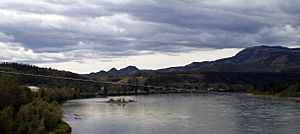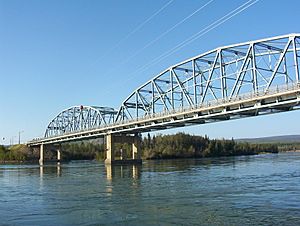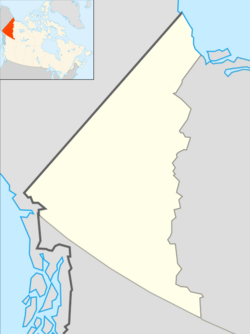Carmacks, Yukon facts for kids
Quick facts for kids
Carmacks
|
|
|---|---|

Carmacks is seen from the Yukon River bridge with the river in the foreground.
|
|
| Country | Canada |
| Territory | Yukon |
| Area | |
| • Land | 36.87 km2 (14.24 sq mi) |
| Population
(2021)
|
|
| • Total | 588 |
| • Density | 13.3/km2 (34/sq mi) |
| • DPL | 206 |
| Time zone | UTC−07:00 (MST) |
| Climate | Dsc |
Carmacks is a small village in Yukon, Canada. It sits right on the Yukon River and is an important stop along the Klondike Highway. It's also where the Robert Campbell Highway begins, connecting it to Watson Lake. In 2021, about 588 people lived here. Carmacks is the home of the Little Salmon/Carmacks First Nation, who are a Northern Tutchone-speaking people.
Contents
A Look Back in Time
Carmacks got its name from a man named George Washington Carmack. In the early 1890s, he found coal near a place called Tantalus Butte. He then built a trading post close to where Carmacks is today. He traded with the local people and even opened a coal mine by the Yukon River.
A few years later, George or his wife, Kate Carmack, made a huge discovery! Along with Kate's brother, Keish (also known as Skookum Jim), and Dawson Charlie (Tagish Charlie), they found gold near Dawson City. This amazing find kicked off the famous Klondike Gold Rush. Carmacks officially became a village on November 1, 1984.
Where is Carmacks?
Carmacks is located where the Nordenskiold and Yukon rivers meet. It's about 180 kilometers (112 miles) north of Whitehorse and 360 kilometers (224 miles) south of Dawson City. You can find it on the North Klondike Highway.
Carmacks is special because it has one of only four bridges that cross the mighty Yukon River. The Campbell Highway also passes through the community. This highway leads to places like Faro, Ross River, and Watson Lake. It's also a way to reach the Canol Road and see some of Yukon's most beautiful scenery.
Weather in Carmacks
Carmacks has a subarctic climate. This means it has short, mild summers and very long, very cold winters.
| Climate data for Carmacks Climate ID: 2100301; coordinates 62°06′54″N 136°11′31.1″W / 62.11500°N 136.191972°W; elevation: 12.2 m (40 ft); WMO ID: 71039; 1991–2020 normals, extremes 1963–present |
|||||||||||||
|---|---|---|---|---|---|---|---|---|---|---|---|---|---|
| Month | Jan | Feb | Mar | Apr | May | Jun | Jul | Aug | Sep | Oct | Nov | Dec | Year |
| Record high °C (°F) | 9.5 (49.1) |
13.0 (55.4) |
17.3 (63.1) |
23.3 (73.9) |
35.0 (95.0) |
35.3 (95.5) |
34.2 (93.6) |
33.0 (91.4) |
27.0 (80.6) |
23.4 (74.1) |
12.8 (55.0) |
10.2 (50.4) |
35.3 (95.5) |
| Mean daily maximum °C (°F) | −16.4 (2.5) |
−10.0 (14.0) |
−1.7 (28.9) |
8.4 (47.1) |
16.5 (61.7) |
21.4 (70.5) |
22.5 (72.5) |
19.9 (67.8) |
13.7 (56.7) |
3.9 (39.0) |
−9.1 (15.6) |
−14.3 (6.3) |
4.6 (40.3) |
| Daily mean °C (°F) | −21.8 (−7.2) |
−17.0 (1.4) |
−9.6 (14.7) |
0.7 (33.3) |
8.3 (46.9) |
13.5 (56.3) |
15.3 (59.5) |
12.8 (55.0) |
7.1 (44.8) |
−1.2 (29.8) |
−13.8 (7.2) |
−19.3 (−2.7) |
−2.1 (28.2) |
| Mean daily minimum °C (°F) | −26.7 (−16.1) |
−23.4 (−10.1) |
−18.1 (−0.6) |
−6.9 (19.6) |
0.0 (32.0) |
5.6 (42.1) |
7.9 (46.2) |
5.6 (42.1) |
0.4 (32.7) |
−6.0 (21.2) |
−17.8 (0.0) |
−23.6 (−10.5) |
−8.6 (16.5) |
| Record low °C (°F) | −57.8 (−72.0) |
−57.2 (−71.0) |
−50.0 (−58.0) |
−33.4 (−28.1) |
−13.6 (7.5) |
−3.9 (25.0) |
−1.1 (30.0) |
−5.0 (23.0) |
−16.5 (2.3) |
−32.5 (−26.5) |
−46.7 (−52.1) |
−54.4 (−65.9) |
−57.8 (−72.0) |
| Record low wind chill | −53.0 | −50.7 | −47.5 | −31.7 | −15.7 | −4.1 | −2.1 | −3.4 | −14.5 | −26.5 | −47.4 | −51.5 | −53.0 |
| Average precipitation mm (inches) | 15.4 (0.61) |
10.2 (0.40) |
10.3 (0.41) |
7.1 (0.28) |
23.5 (0.93) |
31.7 (1.25) |
57.4 (2.26) |
44.9 (1.77) |
24.9 (0.98) |
22.5 (0.89) |
20.5 (0.81) |
18.8 (0.74) |
287.1 (11.30) |
| Average rainfall mm (inches) | 0.0 (0.0) |
0.1 (0.00) |
0.1 (0.00) |
2.7 (0.11) |
23.9 (0.94) |
— | — | — | — | — | 0.0 (0.0) |
0.0 (0.0) |
— |
| Average snowfall cm (inches) | 16.7 (6.6) |
10.8 (4.3) |
10.2 (4.0) |
— | 1.2 (0.5) |
0.0 (0.0) |
0.0 (0.0) |
0.0 (0.0) |
— | — | 20.5 (8.1) |
— | — |
| Average precipitation days (≥ 0.2 mm) | 9.2 | 6.7 | 6.4 | 4.4 | 8.3 | 10.1 | 13.2 | 11.1 | 9.4 | 9.1 | 10.9 | 9.6 | 108.3 |
| Average rainy days (≥ 0.2 mm) | 0.0 | 0.06 | 0.07 | 0.87 | 7.2 | — | — | — | — | — | 0.0 | 0.0 | — |
| Average snowy days (≥ 0.2 cm) | 7.7 | 5.1 | 4.1 | — | 0.53 | 0.0 | 0.0 | 0.0 | — | — | 8.9 | — | — |
| Source: Environment and Climate Change Canada | |||||||||||||
People of Carmacks
| Population Changes in Carmacks | ||
|---|---|---|
| Year | Pop. | ±% |
| 1986 | 404 | — |
| 1991 | 349 | −13.6% |
| 1996 | 466 | +33.5% |
| 2001 | 431 | −7.5% |
| 2006 | 425 | −1.4% |
| 2011 | 503 | +18.4% |
| 2016 | 493 | −2.0% |
| 2021 | 588 | +19.3% |
| Source: Statistics Canada |
||
|
||||||||||||||||||
|
||||||||||||||||||||||||
In the 2021 Census, the Village of Carmacks had a population of 588 people. This was an increase from 493 people in 2016. The village covers an area of about 36.87 square kilometers (14.24 square miles).
A large part of Carmacks' population, about 91.4%, are First Nations people. Most of them belong to the Little Salmon/Carmacks First Nation. Their local language is Northern Tutchone. Elders keep the language alive, and it's also taught to students at the local Tantalus Elementary/High School.
What Carmacks Does
The area around Carmacks is rich in natural resources like coal, copper, and gold. Because of this, there are different mining activities happening nearby. For example, there's a small zinc-copper mine operating close to Carmacks. Also, a gold site northwest of Carmacks is being explored by a company from Whitehorse.
Fun Things to Do
The Carmacks Recreation Centre is a popular spot for young people. It has a youth drop-in program every day where you can use computers, play video games, and enjoy other activities. The gym is used for sports like floor hockey. The Recreation Centre also has a three-lane curling rink, a fitness gym, and a full kitchen for events.
Carmacks also has an indoor swimming pool. It's open to everyone in the community from June to September, which is perfect for summer fun!
Getting Around

You can reach Carmacks by car using the Klondike Highway. If you're traveling by air, there's also the Carmacks Airport.
There have been ideas to connect Carmacks to the Alaska Railroad or extend the White Pass and Yukon Route railway from Whitehorse.
Sports and Events
Every February, Carmacks is an important checkpoint for two big races. One is the Yukon Quest, a long-distance sled dog race. The other is the Yukon Arctic Ultra, a challenging race for people on foot, skis, or bikes.
See also
 In Spanish: Carmacks para niños
In Spanish: Carmacks para niños



